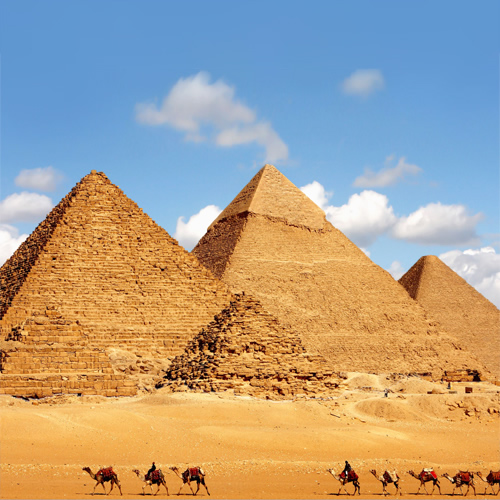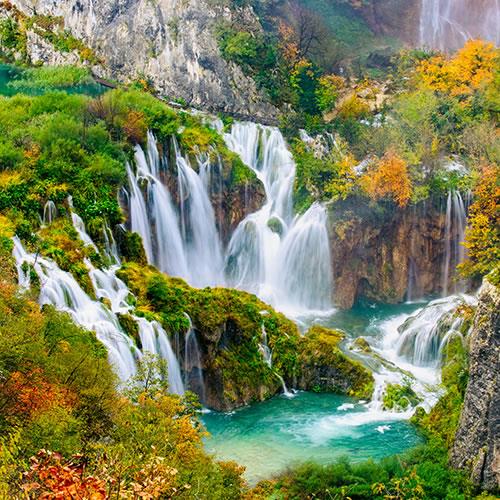
Ruins of the World
Vision and ingenuity are inherent to humankind. Throughout history we have built all manner of structures, whether those be dedicated to worship, protection, entertainment, or socializing. Today we still can’t always agree on what function some of these ruins played in past civilizations, but one thing is for certain: they were built to stand the test of time. Look through our list of the most iconic ruins from around the world and feel inspired to connect with the past.
Ancient Ruins of Europe
The ancient civilizations of the Phoenicians, the Romans, and the Greeks influenced Europe heavily, and the ruins of their once-mighty cities and fortresses are scattered all across the continent. These ancient ruins are beautifully preserved, in many cases to their original classical luster.










The Parthenon is part of the Acropolis, and, even if you don’t care about archaeology, you can’t come to Athens and not visit it. This spectacular building (completed in 432 BCE) symbolizes some of the highest achievements of mankind. It is a cultural landmark: a temple to ancient gods that served as the political, economic, social, and cultural center of ancient Greek life. It has since served as a treasury and even a Christian church. It dominates the city skyline, you cannot miss its presence, and its architecture, art, and visual design are stunning.
The Colosseum and the Roman Forum (completed around 80 CE) is considered one of the greatest works of Roman architecture and engineering. These structures were integral to Roman culture and social life. The Colosseum is the largest amphitheater in the world and still provides the ultimate model for modern sports arenas. It could hold up to 80,000 spectators and it was used for gladiator contests and public spectacles such as mock sea battles, animal hunts, executions, re-enactments of famous battles, and dramas based on Classical mythology. The Forum was the place to see and be seen, it was paramount to political and religious activities. When you visit Rome there is simply no way to miss these icons, they remain favorite tourist draws for a reason!

Ancient Ruins of Africa & the Middle East
The Carthaginians, the Egyptians, the Romans, the Hebrews, and so many other cultures thrived in Africa and the Middle East before the year 1000. Many of their iconic cities and structures are well-preserved today, and count themselves among the most popular tourist destinations in the world.








The Great Pyramid of Giza (Khufu), the oldest of the Seven Wonders of the Ancient World, is the largest of the three pyramids situated in the Giza pyramid complex. The Pyramid is believed to have been completed around 2560 BCE, after about 20 years of near-constant work from thousands of workers. There are three chambers located inside; the lowest chamber was unfinished, and the two higher chambers are said to be the Queen’s and the King’s chambers. Visit famous Cairo (Giza is less than an hour from the city) and make time to see this ancient feat of engineering – among other nearby marvels!


The Western Wall (or Wailing Wall) in Jerusalem is considered to be the holiest site in the world for people of the Jewish faith, though it is also celebrated by Christians and Muslims. Built by King Herod in 20 BCE and destroyed (mostly) by the Romans in 70 CE, the wall managed to survive and today thrives as a pilgrimage site for people of all three major world faiths. People come to pray and often leave their written prayers in cracks in the wall. Anyone can come to worship here, but there are separate areas for men and women.
The awe-inspiring Ancient City of Petra in Jordan is the country`s most valuable treasure. The UNESCO World Heritage Site and one of the Seven Wonders of the Modern World is a unique, vast city carved into the sheer pink and red sandstone rocks. It is a Nabatean city that was lost for thousands of years, only rediscovered in the 19th century. Here you will be able to explore massive ancient temples and tombs along with the spectacular sights from the Mountaintop Monarchy in a city that dates back more than 2,000 years.

Ancient Ruins of Asia
Many of the ancient sites of Asia are so well-preserved that in many cases you wouldn’t even call them ruins! Whether you’re searching for sites important to religious history or military history, the ancient sites of Asia are wondrous to behold.








The Great Wall of China, near Beijing, is one of the most famous monuments in the world. The longest wall in the world stretching for over 5,500 miles through the rugged countryside, deserts, and mountains begins in Shanhaiguan Pass in the east and ends in Jiayuguan Pass in the west. Originally built as a line of defense to protect the Chinese Empire, some parts of the wall date back to the early 7th century, made from stone, brick, wood, and other materials. The wall is a very popular attraction and a UNESCO World Heritage Site, where visitors come to walk and hike and see the breathtaking sights and surroundings.


Angkor Wat, which translates to Temple City or Capital Temple, is a Buddhist temple complex situated about 4 miles north of Siem Reap (Cambodia). It is the largest, and one of the finest, religious monuments in the world. The complex covers 402 acres of land; it was originally a Hindu temple of God during the Khmer Empire and is designed in classical Khmer-style architecture. The UNESCO World Heritage Site is surrounded by a moat and 2 miles long fortified wall, and it consists of chambers, galleries, courtyards, and porches with walkways and steps for visitors to explore.
Beautiful Kyoto, known as the “City of Ten Thousand Shrines,” easily lives up to its nickname. The Shrines of Kyoto consist of over 1,600 Buddhist temples, 400 Shinto shrines, and 17 UNESCO World Heritage sites. In fact, Kyoto is the heart of traditional and religious Japan; this enchanting city almost seems frozen in time. Nestled in the mountains, the surrounding area of the city offers beautiful wide open green spaces – popular for people looking to commune with nature. Plan your trip, or several – even given plenty of time it will be impossible to discover all the city has to offer on one journey! Don’t overlook other important cities that house Temples and Shrines throughout the rest of Japan.

Ancient Ruins of the Americas
There were many ancient civilizations that lived in the Americas before the Europeans arrived by the sixteenth century. These civilizations built entire cities, housing as many as tens of thousands of people, and many of the ruins of these grand cities are open to the public today.









Considered one of the New Seven Wonders of the World, it comes as no surprise the Chichén Itzá ruins are one of Mexico’s top attractions. With only the briefest of interruptions, Chichén Itzá served as a sacred Mayan site for more than 700 years, and by the 11th century had become the political and religious capital of the revived Mayan empire under Toltec rule. Today, it has been listed as a UNESCO World Heritage site and welcomes more than a million visitors each year.
Machu Picchu remains one of the premier archaeological sites in the world and serves as a vivid reminder of the mighty Incan Empire. The citadel is surrounded by iconic Andean peaks and includes temples, residences, fountains, and hundreds of cascading steps. Though researchers can only speculate about its original purpose, its cultural significance cannot be overstated. In 1981, Machu Picchu was named a Peruvian Historic Sanctuary and UNESCO designated it one of their World Heritage Sites in 1983. In 2007, Machu Picchu was voted to be included as one of the New Seven Wonders of the World, where it stands in excellent company!


Easter Island, also known to the locals as Rapa Nui, is one of the most isolated islands in the world. Its name comes from Dutch explorer Jacob Roggeveen who first spotted it on Easter day in 1722. The fascinating island is famous for its giant stone Moai statues, thought to be tombstones carved in the likeness of the deceased, perched on the cliffs and volcanic hills. There are some 1,000 statues, some nearly thirty feet tall and weighing up to 80 tons! Though the statues were built centuries ago, the descendants of their builders still thrive on the island and create their own art, renewing their cultural traditions in an unprecedented renaissance.
More to Explore: We appreciate the ruins above because of the ingenuity of our ancestors, but we cannot overlook the new marvels we have built or the natural wonders the world crafted. Everywhere you look there is something bewildering, and if you don’t stop to appreciate and explore, you are truly missing out!


